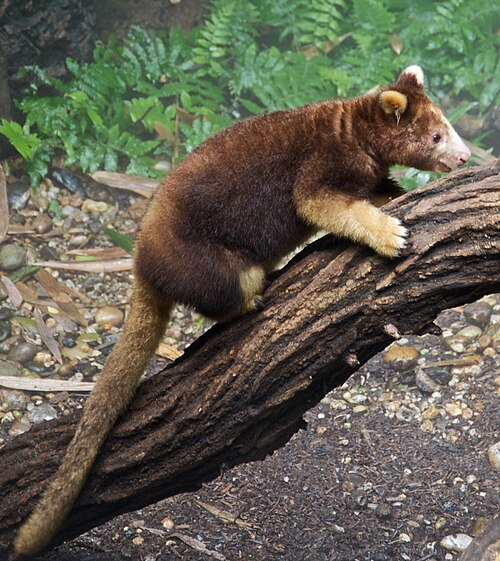Tree Kangaroo Facts for Kids
Tree kangaroos are marsupial mammals known for their agile climbing abilities and unique adaptations to forest life.
View Article For:

Related Articles
Introduction
They belong to the marsupial family, just like their more famous cousins, the kangaroo and koala. There are about 14 different species of tree kangaroos. They can be found mainly in Australia, Papua New Guinea, and Indonesia. Tree kangaroos can leap between branches up to 30 feet (9 meters) and can weigh between 8 and 20 pounds (3.6 to 9 kg). With their strong limbs and fluffy tails, they look quite different from the kangaroos hopping on the ground! 🦘
Interesting Facts
They can spread their limbs to slow down the fall! Also, tree kangaroos can make various sounds, from growls to whistles, to communicate with each other. 🗣
️ Unlike regular kangaroos, tree kangaroos prefer a life in the trees rather than hopping on the ground. Lastly, they have a wonderful sense of smell, helping them find food and avoid danger! 🐨🎉
Conservation Status
Deforestation, caused by logging and agriculture, is a major threat to their homes. Many tree kangaroo species are protected by laws, and conservation efforts are ongoing to save them! 🌿
Organizations are working hard to keep the rainforest healthy and educate people about the importance of protecting these amazing animals. If we all care for the environment, we can help ensure that tree kangaroos thrive in the wild for years to come! ❤
️
Cultural Significance
They are often featured in traditional stories and art. Some communities see tree kangaroos as symbols of strength and resilience. 🐾
The unique characteristics of these animals are celebrated in local folklore. By understanding their significance, we can appreciate how tree kangaroos impact cultures and the environment!
Behavior And Lifestyle
They are solitary animals, meaning they like to spend time alone, although they may come together during mating season. Tree kangaroos are excellent climbers and can leap between branches with great skill! 🌿
They can also be quite curious and often explore their surroundings. Tree kangaroos use their sharp claws to grip tree bark and navigate through the forest's heights.
Diet And Feeding Habits
Their favorite foods are leaves, fruits, and flowers, especially from eucalyptus and fig trees. They can munch on tough leaves thanks to their strong teeth! 🍃
Tree kangaroos usually eat at a leisurely pace, chewing their food carefully. They have strong back legs that help them balance while munching on branches high above the ground. It’s important for them to climb down to the forest floor occasionally to drink water. 💧
Habitat And Distribution
They roam high in the trees where it is safe from predators. Most tree kangaroo species like the Lumholtz's tree kangaroo can be found in the rainforests of Australia, particularly in Queensland. The Goodfellow's tree kangaroo lives in New Guinea, where it enjoys the lush vegetation. 🌄
These beautiful creatures need a lot of trees to thrive, so they are mostly found in tropical areas rich with green plants. When the trees are cut down, their homes disappear, making it hard for them to survive. 🌳❌
Physical Characteristics
Their thick, fluffy fur keeps them warm and camouflages them among the leaves. A typical tree kangaroo is about 3 feet long (1 meter) and has a long tail that can be the same length as its body! Their beautiful coats can be a mix of brown, black, or even golden colors, depending on the species. 😍
They also have large, bright eyes that help them see in the dim light of the forest canopy. 👀
Reproduction And Life Cycle
The tiny joey climbs into its mother's pouch immediately after birth and stays there for several months. The mother carries and protects the joey, allowing it to grow. 🦘
After about 8 months, the joey begins to explore outside the pouch but continues to stay close to its mom. Tree kangaroos usually live to be around 10 to 12 years old in the wild.
DIY is a humongous library of
activities and courses for kids.
Curious?
Gallery of

Did you know?
🌳 Tree kangaroos are native to the rainforests of New Guinea and Australia.
🐾 Unlike their ground-dwelling relatives, tree kangaroos are adapted for life in the trees.
🍏 They primarily feed on leaves, fruits, and flowers, making them herbivorous.
🦘 Tree kangaroos are strong climbers, using their long forelimbs and powerful hind legs to navigate branches.
🌧️ They have a padded foot structure to help them grip on slippery surfaces.
👶 Tree kangaroo young are born underdeveloped and continue to grow in their mother's pouch.
📊 There are several species of tree kangaroos, including the Goodfellow's tree kangaroo and the Lumholtz's tree kangaroo.
🌍 Tree kangaroos play a crucial role in their ecosystems by dispersing seeds.
🎶 Their vocalizations can include low growls and whistles, especially between mothers and their young.
📉 Many species of tree kangaroos are threatened due to habitat loss from logging and agriculture.

